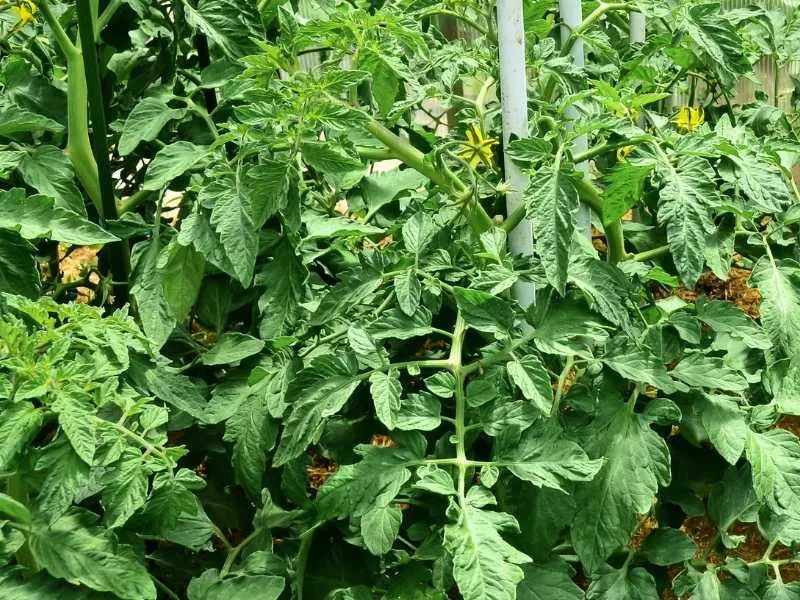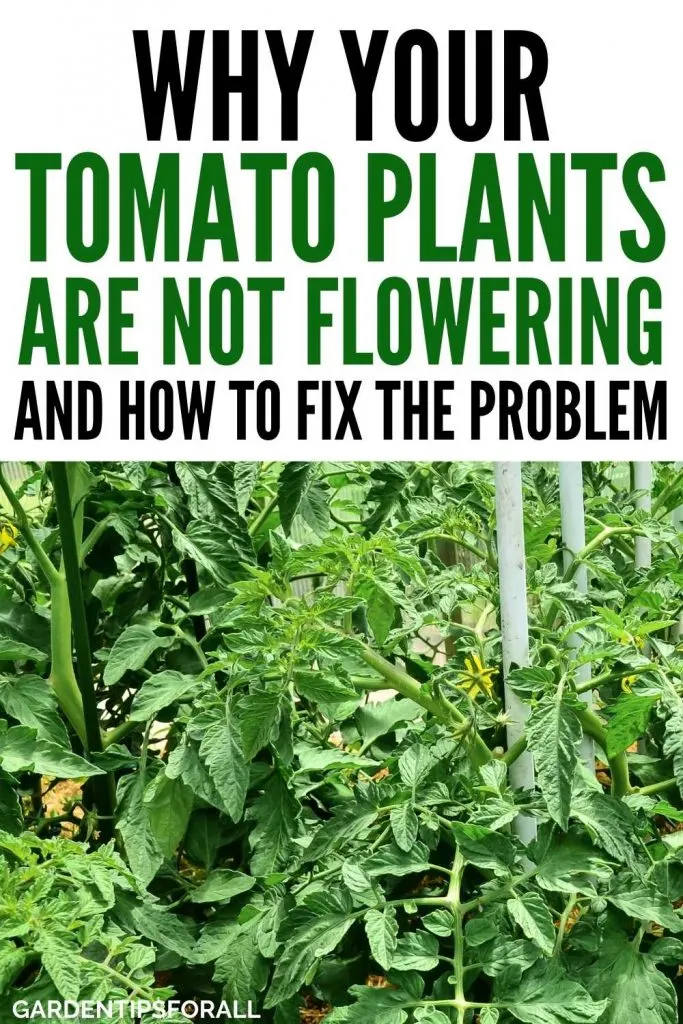Why are My Tomato Plants Not Flowering and How Do I Make them Bloom?
Nothing is more frustrating than having big and beautiful tomato plants but no flowers. Every gardener expects to see yellow flowers blooming after 40-50 days of planting. And when there are no flowers, it means that no fruits will appear as well.
Thus, many people are asking, why are my tomato plants not flowering?

Tomato plants may fail to flower or bloom due to excess nitrogen, inadequate sunlight, lack of water, and very high temperatures. You may also be growing a tomato plant type that isn’t suitable for your region.
But all hope is not lost. You can quickly solve these issues and still harvest some tomatoes for that season.
In this article, we will discuss all of these problems in detail and provide practical tips on how to solve them.
Related Article:
Why Don’t My Tomato Plants Have Flowers?
Excess Nitrogen
Tomatoes require a balanced feed of nitrogen, potassium, and phosphorus to boost the lush growth.
However, too much nitrogen levels will only yield beautiful leaves but no flowers.
Tomato plants prefer more phosphorus to nitrogen in blooming. But how do you identify an excess nitrogen problem?
Signs of excess nitrogen:
- Overly green leaves
- Thin stems
- Healthy look, but stunted growth at maturity
- Prone to pests and diseases.
High Temperatures
Temperatures that are higher than 90 degrees Fahrenheit during the day and 70 degrees Fahrenheit at night, will negatively affect your tomato plants.
Tomato plants literally take a break in too high temperatures and stop blooming or even producing fruits.
Even if there were signs of flowers starting to bloom, they would start falling off.
Inadequate Water
Your tomato plants may fail to bloom due to insufficient watering. Water helps transport essential nutrients inside the plant.
And when there isn’t enough of water, your tomatoes start drooping.
It would suggest you learn when and how to water your plants and adjust the watering schedules as needed.
I will discuss the best practices later in the article.
Type of Tomato Plant
People choose different tomato types for various reasons. Some are heavy producers, while others are famous for their big fruits.
Usually, big fruiters produce less harvest or produce.
For instance, the Mortgage Lifter will only produce six big fruits for a whole season.
However, if you want an abundant harvest, the Brandywine red tomato is your best shot for many medium-sized fruits.
But when choosing a tomato type, make sure you know the conditions it prefers.
For instance, some tomato plants will not bloom during summer, when it’s too hot.
Research the type you have before deciding on how to make them bloom.
Inadequate Sunlight
Tomato plants require 6-8 hours of sunlight every day to thrive and bloom.
If your tomatoes are outside, you will notice them being leggy and weak. If you have them indoors, they start growing their foliage towards the window to reach out for sunlight.
If the sunlight is inadequate, your tomato plants will grow slower as well; hence no flowering and no fruits will appear.
Enough sunlight will enable photosynthesis to take place. Therefore, if they don’t receive enough sunlight for a long time, they will eventually die.
How to Make Tomato Plants Bloom
Now let’s go through some of the things you can do to make your tomatoes flower.
Use the Appropriate Fertilizer
When there’s excess nitrogen, you will need to balance or dilute the excess amount.
You can do this by adding some bone meal or colloidal phosphate to the soil.
However, to avoid nitrogen problems from the start, you should not apply fertilizer until after the fruit set.
According to the University of Missouri Extension, you should apply fertilizers with a higher phosphorus level, lower nitrogen levels, and medium potassium levels for tomato plants.
You also shouldn’t use ammonium nitrate, urea, or any other ammonia fertilizers.
Apply the nitrogen fertilizer in shallow grooves (at least 6 inches into the topsoil) around the plants once every 4-6 weeks and water thoroughly.
Conversely, if you applied manure in prepping, reduce the amount of nitrogen by half.
Prune the Tomato Plants
Also, it would help if you pruned some of the rampant green growth. This will help the plant direct its energy to flower and fruit production rather than feeding the leaves.
Pruning also helps increase the yields of tomato plants as well as extend the harvest season.
Water the Plants Regularly
Monitoring the amount of moisture in the soil is the best way to know when to water and when to stop.
Dig about 6 inches in the soil and observe the moisture levels by pouring some water.
Sandy soil will dry almost immediately, but clay and loam can retain the water for about a week.
Always water your tomato plants by drip irrigation. This method allows accurate watering of the plant on the base into the soil.
Overhead watering is not a suitable method of watering tomato plants because it leaves water on the leaves, creating a spreading ground for diseases.
Besides watering, make sure the soil is well-drained and well aerated. Compost manure (cow manure or chicken manure) helps improve drainage and aeration.
Doing this ensures you tomato plants have strong roots.
Monitor the Sunlight
When transplanting your plants, make sure you do not grow them under a shade or near any tree that may block sunlight from reaching them.
If you have them as indoor potted plants, take them outside daily for the recommended duration (6 to 8 hours).
Note that the bigger the tomato, the more sunlight it needs. Therefore opt for smaller tomato varieties if you live in an area where sunlight is an issue.
However, even though tomatoes love sunlight, too much of it can cause slow ripening and water stress.
So make sure the plant receives direct sunlight in the morning and filtered sunlight during the day when it gets too hot.
To ensure that your tomatoes flower when it’s too hot, you can build a structure around the plant, and place a cloth on it.
The cloth should have an opening facing east so that it lets in direct sunlight in the morning and filters it throughout the day.
Below are other tips for handling tomato plants during temperature fluctuations:
- Mulch will help retain moisture and moderate the soil temperature. Add a layer of straw, grass-clipping, or compost mulch around the base of your tomato plants. Mulch will also prevent any weed growth.
- Do not overwater your tomato plants during a heatwave. Even though plants tend to dehydrate in hot temperatures, avoid overwatering your tomatoes because it will suffocate the roots of your tomatoes.
- Also, do not fertilize with nitrogen when temperatures are 60 F or lower. And you should definitely avoid fertilizing when it’s too hot.
Conclusion – Why Isn’t My Tomato Plant Flowering?
If your tomatoes are not flowering, don’t fret. It’s mostly an issue with the soil conditions, temperature, sunlight, or even the type of plant. And as we’ve established, you can adjust these conditions with a few tweaks. Remember, not all tomato plants flower at the same time. So monitor the plants individually before making any significant adjustments.

